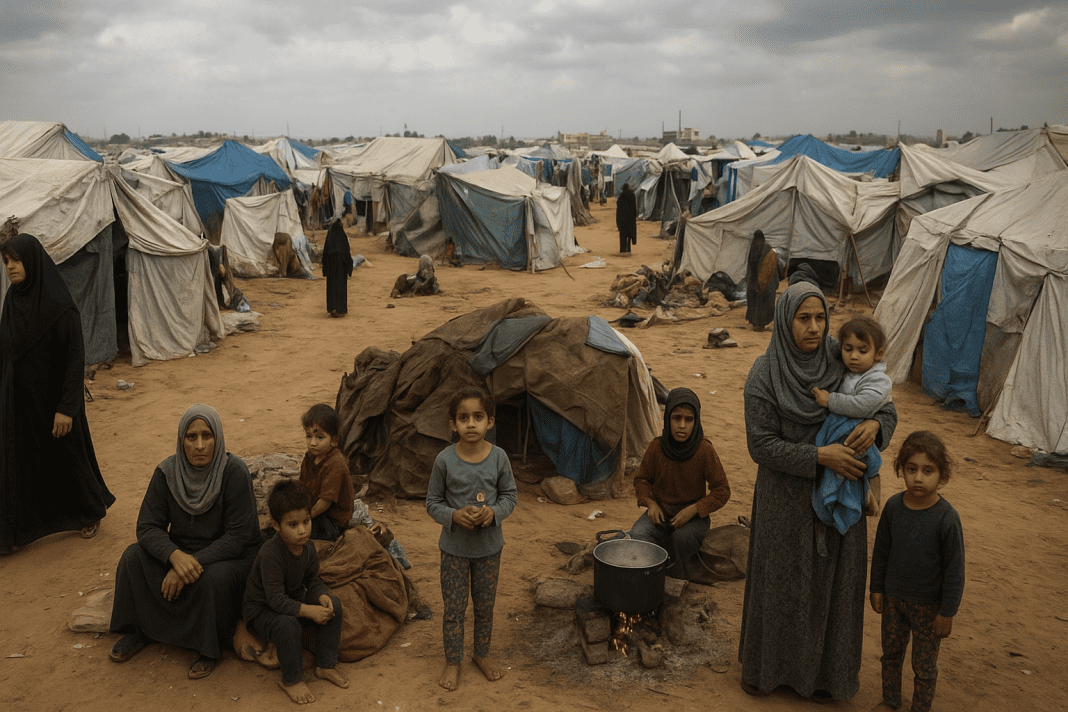The Israeli army has declared Al-Mawasi in Khan Yunis, southern Gaza, a “humanitarian zone.” However, the reality on the ground is completely different. Hundreds of thousands of displaced Palestinians face dire conditions, lacking basic necessities such as food, clean water, shelter, and medical services. Overcrowding, unsafe living conditions, and ongoing military attacks make life especially dangerous for children, women, and older adults.
Al-Mawasi’s Humanitarian Claim Contradicted by Brutal Reality
On 6 September, the Israeli army claimed that Al-Mawasi would provide better humanitarian services. Yet, the area lacks the infrastructure to accommodate the massive influx of displaced people. The Israeli army destroyed buildings and homes in Rafah and Khan Yunis, forcing hundreds of thousands of people to move into Al-Mawasi, which covers about 12,000 dunams, only three percent of the Gaza Strip. Originally agricultural land, it has no proper shelters, roads, or basic facilities to host nearly one million newly displaced residents alongside around 800,000 already living in damaged tents.
Reports from Euro-Med Monitor highlight that this is not the first time Israel has declared Al-Mawasi a “humanitarian zone.” The designation was first used in October 2023 during evacuation orders for Gaza City and eastern Khan Yunis. Despite these declarations, the area continued to face relentless attacks from air, land, and sea, violating international law. In October 2023 alone, Israeli fighter jets carried out 109 airstrikes in Al-Mawasi, killing hundreds and wounding thousands. Military vehicles, drones, gunboats, and artillery regularly targeted displaced people, including those inside tents or during humanitarian aid distributions.
Humanitarian Crisis Looms as Israel Advances Gaza Control Strategy
Al-Mawasi: Site of Death, Starvation, and Destruction
The Israeli army’s designation of Al-Mawasi as a “safe zone” has effectively turned it into a site of mass killings. The dense population and repeated targeting have created extreme physical and psychological suffering. Highly destructive and incendiary weapons target displaced civilians, causing more casualties and trauma among the population.
Authorities or responsible actors fail to meet basic humanitarian standards. Displaced families lack sufficient shelter, food, drinking water, medical care, and essential services. The overcrowded conditions, combined with the absence of sewage systems, leave people vulnerable to diseases and infections. Many live in worn-out tents or even in the open, without protection from heat, cold, or rain. Children, women, and older adults face the greatest risks, with thousands of families living under constant threat of death and injury.
Israel’s Humanitarian Strategy in Gaza Under Fire from UK, France, Canada and Aid Groups
Hospitals in Al-Mawasi, which Israel claims to be functioning, have themselves been targeted. The Nasser Medical Complex faced multiple Israeli attacks, including field executions and enforced disappearances in February 2024. Other medical facilities, such as the Red Crescent’s Al-Amal Hospital and Gaza European Hospital, have been damaged or are out of service. Field hospitals provide limited services and remain at risk, as seen in July when an attack killed a journalist and injured health workers.
Aid distribution has also become perilous. Centers run by the Gaza Humanitarian Foundation have been turned into sites of daily attacks, resulting in 2,362 deaths and over 17,434 injuries. Thousands of families face starvation, without access to medicine or clean water, intensifying the humanitarian crisis.
Humanitarian Violations in Al-Mawasi Documented
International monitors report that displaced people in Al-Mawasi are living in catastrophic conditions, with almost no basic services. Hundreds of thousands are crammed into a tiny area, with no protection from ongoing military operations. The destruction of Rafah, Khan Yunis, and parts of Gaza City has forced more civilians into Al-Mawasi, amplifying overcrowding and resource shortages.
The lack of essential infrastructure—such as hospitals, roads, sewage systems, and food distribution points—makes Al-Mawasi a death trap rather than a safe haven. Civilians are being targeted repeatedly while attempting to access aid, collect water, or seek medical care. This situation exposes displaced populations to continuous risk and violates fundamental principles of international law, which require the protection of civilians in conflict zones.
The international community has documented these violations extensively. Repeated airstrikes, artillery attacks, and the destruction of hospitals and aid centers underline the severity of the humanitarian crisis. Families face starvation, lack of drinking water, inadequate medical care, and unsafe living conditions, making Al-Mawasi a zone of extreme danger rather than the declared humanitarian safe area.

